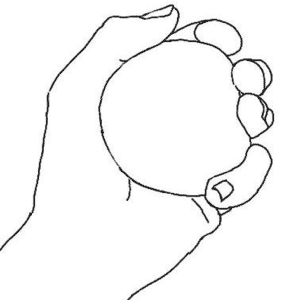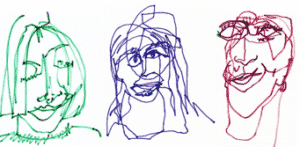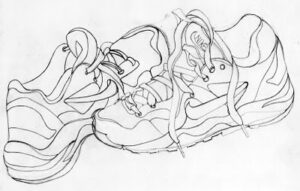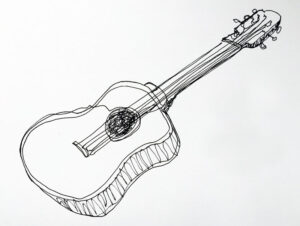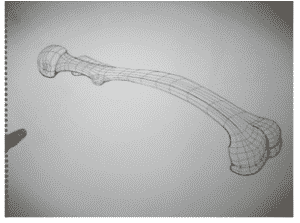5 Types of Contour Drawing and How They Improve Your Art
The beginning of all things?
The time when we first touched the pencil and did various sorts of scribbles to doing realistic drawings, manga, cartoons and anything which you could think of now. Many people get surprised by the skills an artist contains.
But we, the artists, know how long and tough the journey was. How many papers we had to throw to make the line-art ‘perfect’ as per our view. How many times we got creative blocks and got through it. We sometimes complain about it, but it’s a part of the journey, right?
And it all started with drawing lines. Very simple drawings, some even childish to many people’s eyes. But we should never forget the first step that is the ‘Contour Lines’
What are Contour lines?
Contour lines are a set of lines to make a layout with no details or shadings or colours. Think of any primary things to draw let’s say a rectangle, contour drawing is like that. You can also say that it’s nearly a line-art with little details.
All artists do contour drawing. In fact, we do it so many times that unknowingly we forget the value it has given to us and where the masterpieces we created actually started. Let’s discuss the types of the contour drawing and how they improve your art.
- Pure Contour Drawing
Let’s say you want to draw a pencil box, what will you draw first? You will sketch out the layouts, right? Well, if you do the layout, then you can consider it a pure contour drawing. Then we move on the shades and add more of that ‘realistic-details’ or even a cartoony detail cause’ why not? You can say this is the base of everything.
Source Link: – https://www.liveabout.com/pure-contour-drawing-overview-1123087
How it helps you?
Well, remember the time you were 5-10 years or remember the first time you drew? What did you draw first? It usually starts with hundreds and thousands of pages of straight lines. First the line is scrappy and after that you get used to it and move on to do rectangles, squares and the devil itself, a circle.
The first circle, that you cannot even consider it a circle, but after that it becomes a good circle. A perfect circle is hard to get, but it can become easy through practice. After learning about shapes, you get to know about the anatomy.
Then you do figures. All this comes under pure contour drawing. After it’s done, we give it more shades to make it more realistic. Pure Contour Drawing is what you would consider the basic before giving it more details and shades and colours.
Many of us stop using the pencil and move to watercolours and stuffs like that. But we should always remember to stay stuck to our roots. Practice more to get better cause’ if your base is not strong then your building will probably fall.
- Blind Contour Drawing
This means that you see only the object you are drawing and not the paper. In a nutshell, you draw without seeing the paper. Even if you have to change your pencil size, you have to do so without seeing which pencil we will take.
Source Link: – https://www.artsy.net/article/artsy-editorial-blind-contour-drawing-help-better-artist
How it helps you?
You may be outraged, like, “I cannot even draw this thing and you are telling me to draw without seeing what I am drawing?!” The straight-forward answer, “Yes”.
Let us take a quick example, suppose you are drawing a box in a normal manner, what do you do? You look down at the paper then at the box then from the box again at the paper, and the cycle goes on. This disturbs your focus on the object.
Now, if you just look at the box and draw, at first, it may not even look like a box, with no dimensions, or anything. And, this is what your eyes see. When you take a closure look, while your eyes are focusing on the object, your hands are drawing the things this helps you to draw better.
But do know that as it would increase your focus and would help you see the minor details, it won’t happen overnight. So, stay motivated.
- Modified Contour Drawing
This is very simpler to blind contour drawing, except that you see the paper once in a while.
Source Link: – https://docs.google.com/document/d/1V5ExGZxnynC43YCpu0ww8zjfpMGwR1gE2aj266qJGXU/edit?hl=en_US
How it helps you?
Let’s take an example, you want to draw your hand so you place it on the piece of paper, and try to draw it observing the object (over here, the hand) most of the time. Now, suppose you just want to have a quick look and you see that you’ve made a mistake.
So, you erase it out and then observe the parts and do it again. The major advantage over here is that you can see the work sometimes. It might be difficult at the first, so set your boundaries and limit yourself looking at the paper.
- Continuous Contour Drawing
This means that you draw a figure with one line without lifting your hands from the paper.
Source Link: – https://thevirtualinstructor.com/continuous-line-drawing.html
How it helps you?
This gives your brain a workout. You need to think where your next line is going to be so that you can complete the puzzle.
You can learn from the mistakes. As you plan, you are always on the lookout for not making mistakes. Sure, mistakes are how artists learn. But sometimes, we just forget about it and erase. Here, if you make a mistake, then congratulations! You made the puzzle even harder, and now you have to solve it with your creative skills.
This is how you learn from the mistake; you cannot erase the lines instead you need to think to solve the puzzle!
- Cross Contour Drawing
The name is self-explanatory. It means that all lines to show depth, dips, turns, and things that really matter to make your art pop-up using curved lines.
Example: –
Source link: – https://www.flickr.com/photos/_dakini_/2847053177
How it helps you?
It increases your observational skills. Let’s say you see a ball, and then think how many dips you need to make at the bottom. If you make a mistake in this one, then it would look something you do not want it to be.
How to improve your contour drawing?
Start with simple objects. It can be an apple, a boring box that’s been gathering dust, anything which has a simple layout.
- Draw fast: Contour drawings are nice but they are not the finished artwork. By drawing quick contour lines, you can go what you think is right and stop over analyzing a single thing (*really both the eyes look pretty*)
- Stop being a perfectionist: Throw that ‘perfectionist cap’ while it is art. Nothing is PERFECT, art is subjective. Do not make your contour drawings perfect. Are you telling me that you can draw that teddy bear perfectly without seeing the paper?
- Make a schedule: Contour drawing is fun, but as always, you will get bored at some point. So, promise yourself that you will do 5 contour drawings this month or increase or decrease the numbers as per your time and requirements. But practice!
- Try to connect: Suppose you are drawing a face, and you’ve contour drawn the eyes and the nose. Then you complete the work. After that, you look through other images of faces. Congo! Cause’ now you know more about it than the person who does not know much about contour drawing.
Conclusion
Contour drawing is fun. It expands your thinking process and prepares some barriers. But remember, that it won’t happen over-night. So, that’s said, keep practicing and creating. And, let us know in the comments about your thoughts and opinions on this matter!

